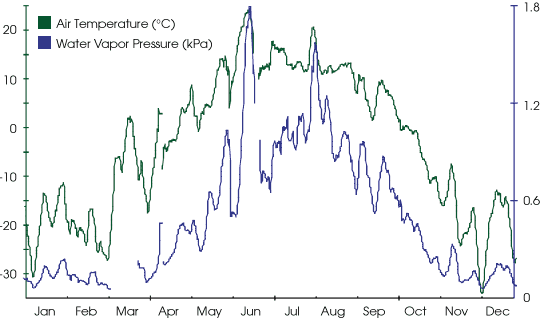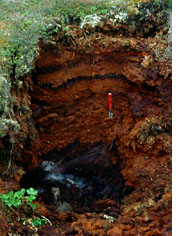

| The Green Desert |
| ||
| "When you fly over the boreal forest, it appears to be a very wet ecosystem—lush and green," observes Forrest G. Hall, physicist and BOREAS project scientist at NASA’s Goddard Space Flight Center. "You see so many lakes and fens, and in the spring the ground is covered by melting snow. But the atmosphere is very dry, more closely resembling that over a desert than you would expect over a wet forested region." | |||
 | |||
| The lower atmosphere is so dry, in fact, the BOREAS team nicknamed
the boreal ecosystem "the green desert." Afternoon humidity
in May is often as low as 30 percent there, whereas tropical forests
have an average afternoon humidity of 60 percent. According to Betts,
the atmospheric boundary layers that form over the boreal forest
often resemble those boundary layers that form over the southwestern
United States. They can become very deep (up to 8000 feet, or 2500
meters) and very turbulent. ["Boundary layer" refers to the
part of the atmosphere closest to Earth’s surface; it is typically
very turbulent as large amounts of heat, aerosol particles, and trace
gases are mixing in it and passing through it.]
"There is very little evaporation (in the boreal ecosystem) in
the spring and summer," Betts observes. "An enormous amount
of sunlight is being absorbed by the forest canopy and then emitted back
into the atmosphere as heat. Consequently, it can get very warm
there—up into the 80s Fahrenheit (30 Celsius) in early
June." |
The above graph shows air temperature and water vapor pressure during 1995 above the canopy of the northern BOREAS old black spruce site. The air is relatively dry all year long. In contrast, summer water vapor pressure near Washington, DC (a humid area) may peak at 2.5 kPa when the temperature is 25°C. (Graph by Robert Simmon, based on data from Sutton, Doug, Mike Goulden, and Steven Wofsy. 1998. BOREAS TF-03 NSA-OBS Tower Flux, Meteorological, and Soil Temperature Data. Available online from the ORNL Distributed Active Archive Center, Oak Ridge National Laboratory, Oak Ridge, Tennessee, U.S.A.) | ||
 But, ironically, while the boreal air in springtime is hot and dry like a desert’s, the ground under the coniferous forests is
still frozen, a foot or two down. So, while the forest canopy is
absorbing tremendous amounts of sunlight and storing it as heat, water cannot evaporate from the
trees as long as their roots are frozen (Betts et
al., 1999). Likewise, while the lakes in the region have all melted in
late spring, they are still very cold—too cold to release much
water. But, ironically, while the boreal air in springtime is hot and dry like a desert’s, the ground under the coniferous forests is
still frozen, a foot or two down. So, while the forest canopy is
absorbing tremendous amounts of sunlight and storing it as heat, water cannot evaporate from the
trees as long as their roots are frozen (Betts et
al., 1999). Likewise, while the lakes in the region have all melted in
late spring, they are still very cold—too cold to release much
water.
Typically, evaporation, or the release of water vapor from the
surface up into the atmosphere, provides forest ecosystems with a means
of cooling off or regulating temperature. As sunlight warms the
surface, evaporation from bodies of water and from the water vapor
released by trees cools the surface. But in the boreal ecosystem, where
very little evaporation occurs in the spring, most of the sun’s
energy is absorbed and re-radiated back up into the lower atmosphere as
heat; hence the deep, dry and very turbulent boundary layer.
|
Soil which remains frozen year round is called permafrost, and is often found in the far north. Even though summer air temperatures in the boreal forests are quite warm, the upper layers of soil insulate the deep soils, preventing them from thawing. Over time, several meters of permafrost can eventually accumulate. (Image courtesy Canadian Soil Information System) | ||